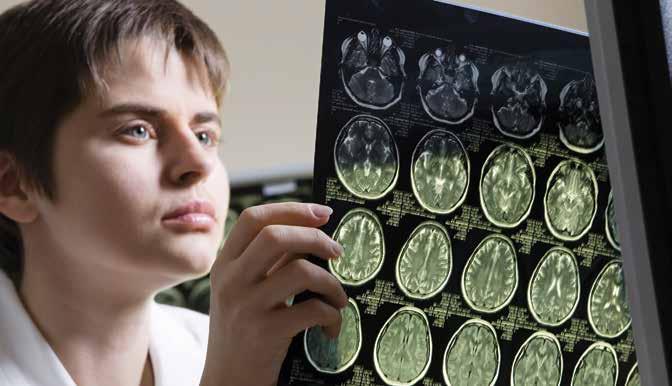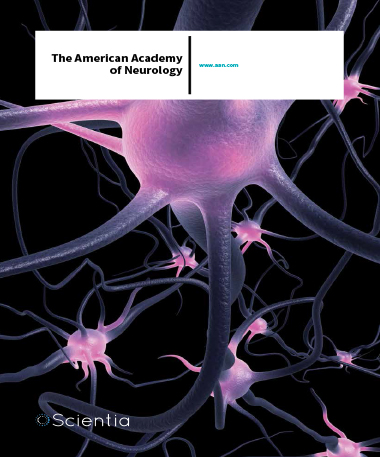The American Academy Of Neurology
 Founded in 1948, and now representing more than 30,000 individuals worldwide, the American Academy of Neurology (AAN) is the world’s largest association of neurologists and neuroscientists. From funding and disseminating the latest research, all the way through to encouraging young people to pursue careers in neurology, the AAN’s mission is to promote the highest quality patient-centred neurologic care and enhance the career satisfaction of its members. For this edition of Scientia, we had had the pleasure of speaking to Dr Terrence L. Cascino, MD, the President of the American Academy of Neurology, who tells us all about the AAN’s activities in education, research dissemination, funding, policy making and more.
Founded in 1948, and now representing more than 30,000 individuals worldwide, the American Academy of Neurology (AAN) is the world’s largest association of neurologists and neuroscientists. From funding and disseminating the latest research, all the way through to encouraging young people to pursue careers in neurology, the AAN’s mission is to promote the highest quality patient-centred neurologic care and enhance the career satisfaction of its members. For this edition of Scientia, we had had the pleasure of speaking to Dr Terrence L. Cascino, MD, the President of the American Academy of Neurology, who tells us all about the AAN’s activities in education, research dissemination, funding, policy making and more.
 Please give our readers a brief introduction to the AAN, and tell us a little but about your mission.
Please give our readers a brief introduction to the AAN, and tell us a little but about your mission.
The AAN was founded in Minneapolis, MN, in 1948 by A.B. Baker, MD, FAAN, chair of the University of Minnesota neurology department. Starting with fewer than 400 members, the AAN now represents more than 30,000 neurologists, with approximately 24,000 in the US and 6,000 international members. We are the world’s largest professional association of neurologists, and the leading online resource for neurologists across the globe. The AAN’s vision is to be indispensable to our members. Our mission is to promote the highest quality patientcentred neurologic care and enhance member career satisfaction.
Who are your members, and what are the benefits of being a member of the AAN?
Our members include medical students, residents and fellows, neurologists in private practice and in academic institutions, and neuroscientists. Some memberships are tiered and customised to the particular needs of those in the profession, such as nurse practitioners, physician assistants, and business administrators. We also have senior members who have retired or are moving toward retirement yet want to stay on top of the latest developments in neurology.
Most member benefits are available to all members, such as significant discounts on conferences, services, and products. Members receive free issues of our suite of Neurology® journals, our patient education magazine Neurology Now® that they can share with patients, and the monthly member magazine AANnews®. We offer a wealth of resources, including free continuing medical education for maintenance of certification, evidence-based practice guidelines and advisories. Our NeuroTracker™ tool provides members with a convenient one-stop shop for tracking both AAN and non-AAN activities, such as CME credits.
We also offer a variety of leadership development programs to nurture talents across a diverse range of members. Our advocacy program provides opportunities to travel to Washington, DC, to take our messages to Congress, and intensive advocacy training to members who want to create change in their practices, institutions, and communities.
Please tell us about the many ways that the AAN supports neuroscience research. What grants are available for researchers, and what areas of research do you consider the most important?
For more than 20 years, AAN research awards have been a crucial resource for young, promising researchers and a springboard to future grant support from the National Institutes of Health and other organisations. We recently made a significant expansion of our investment in research, bringing the total amount to $2.8 million for 2016 – and we plan an even larger increase next year. Our research support is made possible by funds from the AAN; the American Brain Foundation; association partners such as the Parkinson’s Disease Foundation, the ALS Association, the Tourette Association of America, and the National Multiple Sclerosis Society; partners in the pharmaceutical industry; and from our generous members. This has enabled us to create two new awards for career development and neurology research training, in addition to our scholarships and awards for clinical research training, clinician-scientist development, practice research training, and mentored clinical and population research. We don’t rank any as ‘most important’ as they all serve vital needs in finding cures and treatments for people with neurologic disease and improving delivery of care. Promoting research is a mainstay of our Annual Meeting, where we share as many as 2,700 abstracts with more than 12,000 attendees from the neuroscience community. Our Breakthroughs in Neurology and Sports Concussion conferences also feature important cutting-edge research. We also share this knowledge through our Neurology publications. And we recognise leading researchers – from medical students to legends of the labs – with highly coveted awards at our Annual Meeting.
Does the AAN facilitate international collaboration? Tell us about how the AAN supports research that may not be entirely US-based.
The AAN offers a number of significant opportunities to assist and promote international collaboration. Our flagship journal Neurology is a prime example: In 2015, about 48% of our papers were from international authors, and the journal publishes international translated editions for Argentinian, Chinese, and Korean audiences. There also is an Indian edition in which the articles are English.
Neurology: Without Borders is a regular journal feature and an accompanying web blog that examines neurologic medical education, research endeavors and clinical care in global, resource-limited settings with a forum for timely and relevant communications about the most prescient issues, activities, and developments pertinent to the advancement of neurology in these regions of the world.
The Academy supports a vibrant Global Health Section comprised of interested neurologists, and integrated sessions focusing upon global health issues have become standard at the AAN’s Annual Meeting, which attracts thousands of international neurologists. And we recognise the accomplishments of international researchers with fellowships and prestigious scientific awards.
 Describe some of the ways that the AAN supports clinical trials, and how do you help researchers achieve more meaningful outcomes for patients from these trials?
Describe some of the ways that the AAN supports clinical trials, and how do you help researchers achieve more meaningful outcomes for patients from these trials?
Clinical trials are featured extensively in Annual Meeting programs, and the AAN promotes peer-reviewed results from clinical trials through the journal Neurology and press releases to media. The AAN has advocated for legislation to protect individuals from losing private insurance health coverage for routine medical care when participating in clinical trials for neurologic disease. The Academy also regularly informs readers of Neurology Now about opportunities and advances learned in clinical trials; the June/July 2015 issue provided an extensive primer on such trials, explaining what they are and how readers can get involved and make a significant contribution to science.
Please describe one or two major achievements in neuroscience research that the AAN has been involved with in the last few years.
The AAN is committed to making a profound difference in the lives of researchers, and in turn making a difference in the lives of patients with brain disease.
The new 2017 AAN Research Program exemplifies our dedication to promoting neurology and neuroscience research and training, marking our pledge to support all types of research across all career levels and discovery stages.
Scientific and medical communities have called the shortage of investigators a crisis that will impact far more than the 50 million Americans currently affected by a neurologic disease. Recognising this critical need for neurology research, the AAN has dedicated its grantmaking efforts to fulfilling this need.
What journals and magazines do the AAN publish, and what is the AAN’s position on knowledge dissemination and education?
One of the main reasons the AAN was founded was to provide continuing education to neurologists to help them stay current on the latest developments in the profession. Published since 1950, Neurology® is the premier peer-reviewed journal for clinical neurologists. In recent years, it has become the ‘hub’ for several ‘spoke’ journals that serve particular interests of our members, such as Neurology® Clinical Practice, Neurology® Genetics and Neurology® Neuroimmunology & Neuroinflammation.
Continuum: Lifelong Learning in Neurology® is the official continuing medical education journal of the AAN. It is an in-depth, clinically oriented review journal for the practicing neurologist, residents and fellows, and medical students. Written by authors who are experts in their field, each bimonthly issue contains up-to-date knowledge around a single topic area in neurology geared toward the practicing neurologist.
Neurology Today® reports on breaking news, issues, and trends in the practice and science of neurology, reaching more than 20,000 professionals. This twice-a-month magazine delivers credible, up-tothe- minute, balanced, cutting-edge reporting and commentary for today’s busy neurology professionals. AANnews®, the AAN’s monthly member magazine, promotes the Academy’s conferences and Annual Meeting; free education opportunities for maintenance of certification; public and regulatory policy updates and grassroots advocacy opportunities; research fellowships and scientific awards; and other news, products, and services designed to enhance the work of our members.
Finally, the AAN also publishes the bimonthly patient education magazine Neurology Now®, which provides patients and their caregivers with credible, up-to-the-minute, balanced coverage of the latest advances in neurology research and treatment, all written in concise and easy-to-understand language.
Please tell us about the ‘Neuroscience is…’ campaign, and the AAN’s position on public outreach.
Neuroscience Is…TM is the AAN’s new four-pronged campaign to build public awareness and demonstrate the importance of neuroscience research in care of neurology patients and the development of cures for brain diseases. The campaign seeks to provide children and young adults with access to education on the brain and nervous system, and inspire a love of neuroscience from an early age, and to encourage a desire in college and medical students to seek careers in neurology, and support residents and fellows pursuing research as a career. Furthermore, it aims to make the connection in the public and in practicing physicians that neuroscience and neurology research are the reasons that cures, therapies, and treatment options are available. Finally, the campaign ensures that the criticality of brain research is so ‘in the muscle’ of our legislative process that funding for neuroscience is a given each year, and not something which must be fought for and justified each year.
The Neuroscience Is… campaign has four components:
Neuroscience Is… TM Cool is geared toward K-12 students. It incorporates unusual and fun facts about the brain and nervous system to attract the attention of young minds and help shape a lifelong interest in and commitment to the neuroscience field.
Neuroscience Is… TM Rewarding will inspire medical students to select a career in neurology by increasing their awareness of the impact that neuroscience has on the prevention, diagnosis, and treatment of as many as 600 known types of brain diseases.
Neuroscience Is… TM Essential speaks to practicing neurologists and other neuroscience professionals by using compelling facts to demonstrate how research is critical to patient care and day-today practice.
Neuroscience Is… TM Critical underscores the simple fact that without support from government agencies, industry, and the general public, there is not enough funding to sustain neuroscience research. Without research, there are no treatments. And without treatments, there are no cures. This initiative raises awareness of the AAN’s support of researchers and access to practitioners to conduct trials and trial recruitment.
The AAN hosts a daylong family-friendly Brain Health Fair for the communities where we hold our Annual Meetings, sharing the latest developments in neuroscience with thousands of people living with brain disorders as well as their caregivers and families. We have expert speakers on hand and special activities to encourage young people to better appreciate and care for their brains—and perhaps even become neurologists as well. We also have an annual Neuro Film Festival that solicits and shares on YouTube short, personal homemade videos about the effects of brain disorders on people and the need for more research.
Our outreach continues with our patient magazine Neurology Now and the series of disease-specific Neurology Now Books that help educate the public – particularly patients and caregivers – about a range neurologic disorders.
How does the AAN engage with policy makers to ensure patients receive the benefits of ongoing neuroscience research? Tell us about one or two of your achievements in this regard to date.
The AAN has a robust US-focused advocacy program that represents neurologists and their patients on local, state, and national levels. We have a strong grassroots involvement of our members, and have had a staffed office in Washington, DC, since 2005. Some of our most significant advocacy ‘wins’ have focused on lobbying Congress for increased research spending. Just last March, 185 AAN member advocates went to Capitol Hill to ask Congress for increased funding for the BRAIN Initiative at the National Institutes of Health (NIH). In June, the Senate Appropriations Committee approved a $100 million increase for the BRAIN Initiative ($250 million total) for fiscal year 2017. The Senate package also included significant increases in funding for the overall NIH budget by $2 billion to a total of $34 billion, which included a $400 million increase for Alzheimer’s disease research ($1.39 billion total). We also have been in the forefront of successfully advocating for greater research and improved treatment for traumatic brain injury and sports concussion.
Finally, what do you consider to be the biggest challenges currently facing neurology and neuroscience today? How is the AAN working to overcome these challenges?
Every day, our staff of 160 professionals and hundreds of volunteer members are working to demonstrate the value, quality, and safety of neurology and neuroscience. Research is of paramount importance if we are to have more effective treatments and cures and we are continually advocating for increased funding from outside agencies to support new discoveries and breakthroughs.
We are steadfastly committed to ensuring the viability of various practice types, from solo and small practices to large clinics and hospitals. As our recently completed study of job burnout among neurologists has verified, practicing neurologists are overwhelmed by the constant regulatory hassles that take time away from their patients and rob them of the enjoyment of their careers. This can drive away young, promising medical students and residents who might become neurologists at a time when we are facing significant shortages to treat our aging population. So we have created a new Live Well campaign to help our members with tools and resources to identify, mitigate, and prevent burnout. And we continue to fight for them against unnecessary and overly complicated regulations so they can spend more time and energy with the patients they serve.

